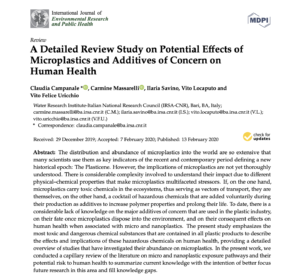This is an explanation of how microplastics and additives can affect human health, as published in:
Published In: The International Journal of Environmental Research and Public Health
Published On: Feb 13, 2020

Key Takeaways:
- This is a review, which draws from the available research to summarize what is known about how microplastics and chemical additives effect human health.
- The study covers plastic “additives of concern” which are classified as hazardous by the EU and are present in everyday products. It focuses on endocrine disruptors and covers the most prominent of them:
- BPA
- Phthalates
- Heavy Metals
- Flame Retardants
- Micro and nano-plastics – the study summarizes research that shows how these particles get into our body and the effects they can have once there. Our primary exposure is through ingestion via the food we eat, which is often contaminated with micro and nano-plastics. Once in our body these particles and associated chemicals can have a variety of negative health implications.
Summary
Effects of Micro and Nanoplastics on Human Health
Entry Points and Exposure:
- Mainly through ingestion of contaminated food.
- Found in sugar, salt, alcohol, bottled water, and plants (fruits and vegetables).
- Marine species consumption is a well-known source.
Absorption and Impact:
- Small particles (<150 µm) can cross the gastrointestinal epithelium, leading to systemic exposure.
- Absorption rates are low; 0.3% expected to be absorbed, and an even smaller fraction can reach organs and pass through blood-brain barriers.
- Concerns about low exposure concentrations due to analytical challenges in detecting micro and nanoplastics.
Mechanisms of Entry:
- Particles <2.5 µm enter the gastrointestinal tract through endocytosis or paracellular persorption.
- Nanoplastics’ absorption through the skin is more probable than microplastics.
Toxicity and Health Effects:
- Microplastics have high affinity for hydrophobic and persistent organic pollutants, antibiotics, and heavy metals, potentially introducing these into the human body.
- Studies show cytotoxic effects on human cell lines, including T98G (brain cells) and HeLa (epithelial cells).
- Effects include cytotoxicity, hypersensitivity, unwanted immune responses, and acute responses like hemolysis.
Additives of Concern
Overview:
- Focuses on hazardous substances in plastics affecting human health.
- Highlights Bisphenol A (BPA), Phthalates, Heavy Metals, and Flame Retardants.
- Each additive has unique toxic effects, including endocrine disruption and cancer risk.
BPA:
- Used in polycarbonate plastics and epoxy resins.
- Leaches from products, contaminating food and water.
- Estrogenic effects; linked to obesity, cardiovascular disease, and cancers.
- Regulatory actions have been taken due to its harmful properties.
Phthalates:
- Serve as plasticizers to increase flexibility in plastics.
- Endocrine disruptors affecting reproduction and development.
- Regulatory bans on certain phthalates in toys and childcare products.
- Found in high volumes in the environment, raising significant health concerns.
Heavy Metals:
- Include metals like lead, cadmium, and mercury used in plastics.
- Cause various health issues, including cancer, bone, and nervous system damage.
- Classified by regulatory agencies as carcinogens and toxicants.
- Environmental contamination from these metals poses significant risks.
Flame-Retardants:
- Chemicals added to plastics to prevent fires.
- Include brominated and chlorinated compounds.
- Linked to endocrine disruption and potential carcinogenicity.
- Concerns over environmental persistence and bioaccumulation.
